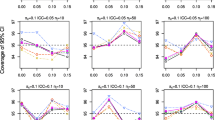Abstract
We consider the case of a multicenter trial in which the center specific sample sizes are potentially small. Under homogeneity, the conventional procedure is to pool information using a weighted estimator where the weights used are inverse estimated center-specific variances. Whereas this procedure is efficient for conventional asymptotics (e. g. center-specific sample sizes become large, number of center fixed), it is commonly believed that the efficiency of this estimator holds true also for meta-analytic asymptotics (e.g. center-specific sample size bounded, potentially small, and number of centers large). In this contribution we demonstrate that this estimator fails to be efficient. In fact, it shows a persistent bias with increasing number of centers showing that it isnot meta-consistent. In addition, we show that the Cochran and Mantel-Haenszel weighted estimators are meta-consistent and, in more generality, provide conditions on the weights such that the associated weighted estimator is meta-consistent.
Similar content being viewed by others
References
Cochran WG (1954) Some methods of strengthening the common ϰ2 tests. Biometrics10, 417–451
Cooper MR, Dear KBG, McIntyre OR, Ozer H, Ellerton J, Cannellos G, Duggan B, and Schiffer C (1993) A randomized clinical trial comparing Melphalan/Prednisone with and without α-2b interferon in newlydiagnosed patients with multiple myeloma: A cancer and leukemia group B study. Journal of Clinical Oncology11, 155–160
Greenland S, Robins JM (1985) Estimation of a common effect parameter from sparse follow-up data. Biometrics41, 55–68
Hutton JL (2000) Number needed to treat: properties and problems. Journal of the Royal Statistical Society A163, 403–19
Kleinbaum DG, Kupper LL, and Morgenstern H (1982) Epidemiologic Research. New York, Van Nostrant Reinhold
Laupacis A, Sackett DL, and Roberts RS (1988) An assessment of clinically useful measures of the consequences of treatment. New England journal of medicine318, 1728–1733
Lipsitz SR, Dear KBG, Laird NM, Molenberghs G (1998) Tests for homogeneity of the risk difference when data are sparse. Biometrics54, 148–160
Mantel N and Haenszel W (1959) Statistical aspects of the analysis of data from retrospective studies of disease. J Natl Cancer Inst22, 719–748.
O'Gorman TW, Woolson, RF, Jones MP (1994) A comparison of two methods of estimating a common risk difference in a stratified analysis of a multicenter clinical trial. Controlled Clinical Trials15, 135–153
Petitti DB (1994) Meta-analysis, decision analysis and cost-effectiveness analysis: methods for quantitative synthesis in medicine. Oxford University Press
Shadish WR, and Haddock CK (1994) Combining estimates of effect size. In: Cooper H, and Hedges LV (editors) The Handbook of Research Synthesis. New York, Russell Sage Foundation, 261–84.
Author information
Authors and Affiliations
Rights and permissions
About this article
Cite this article
Kuhnert, R., Böhning, D. The failure of meta-analytic asymptotics for the seemingly efficient estimator of the common risk difference. Statistical Papers 46, 541–554 (2005). https://doi.org/10.1007/BF02763004
Received:
Revised:
Issue Date:
DOI: https://doi.org/10.1007/BF02763004




